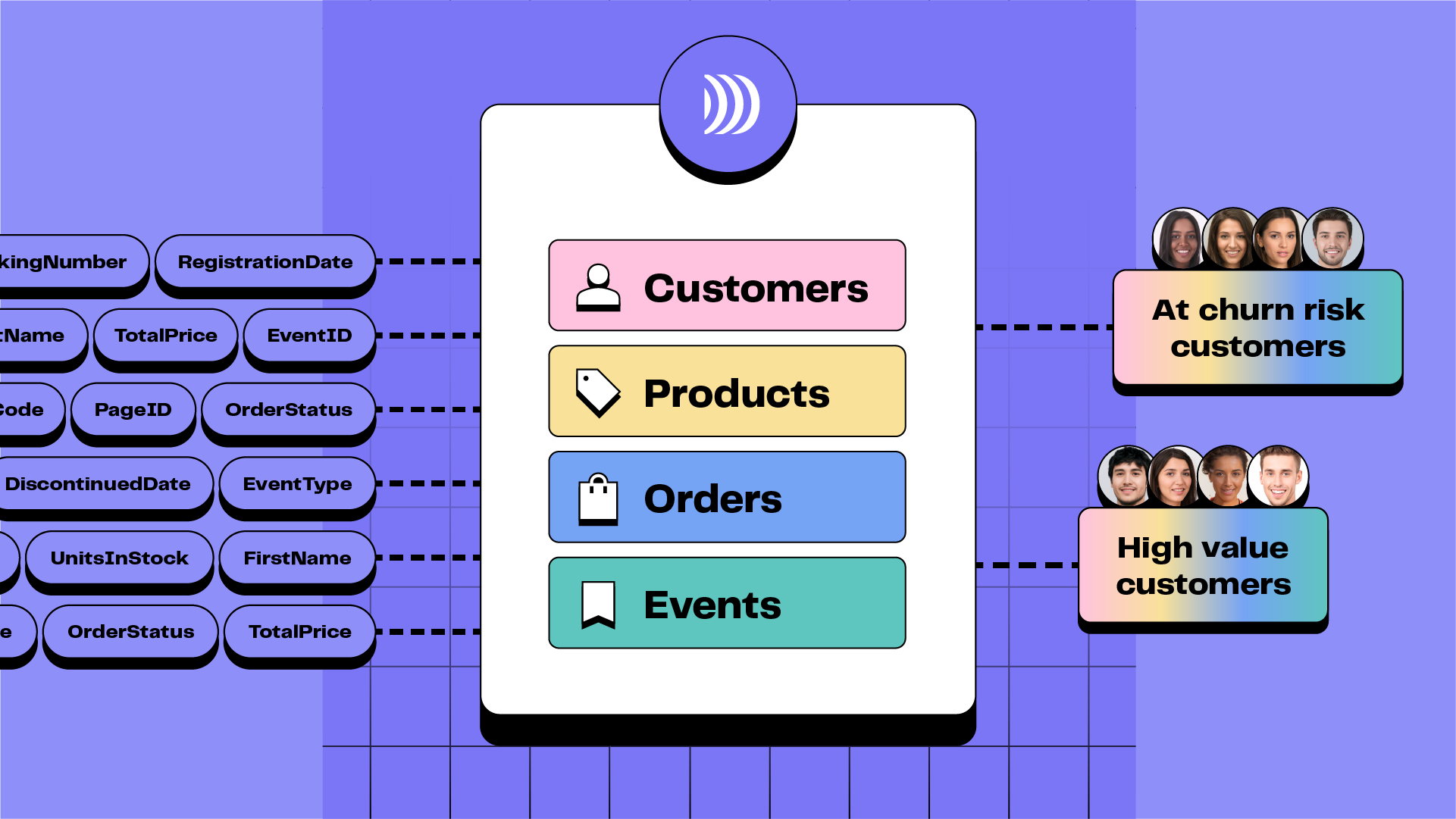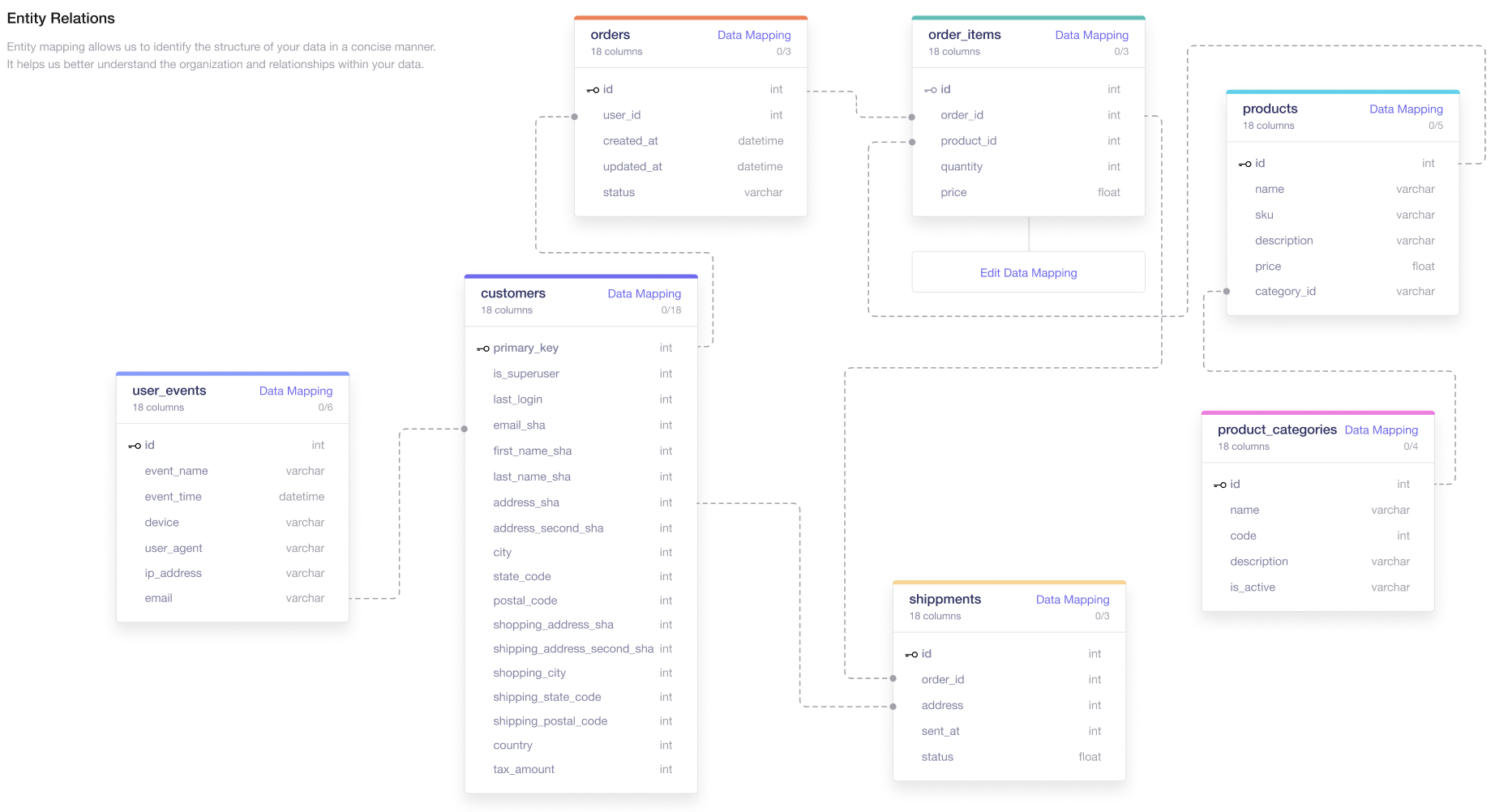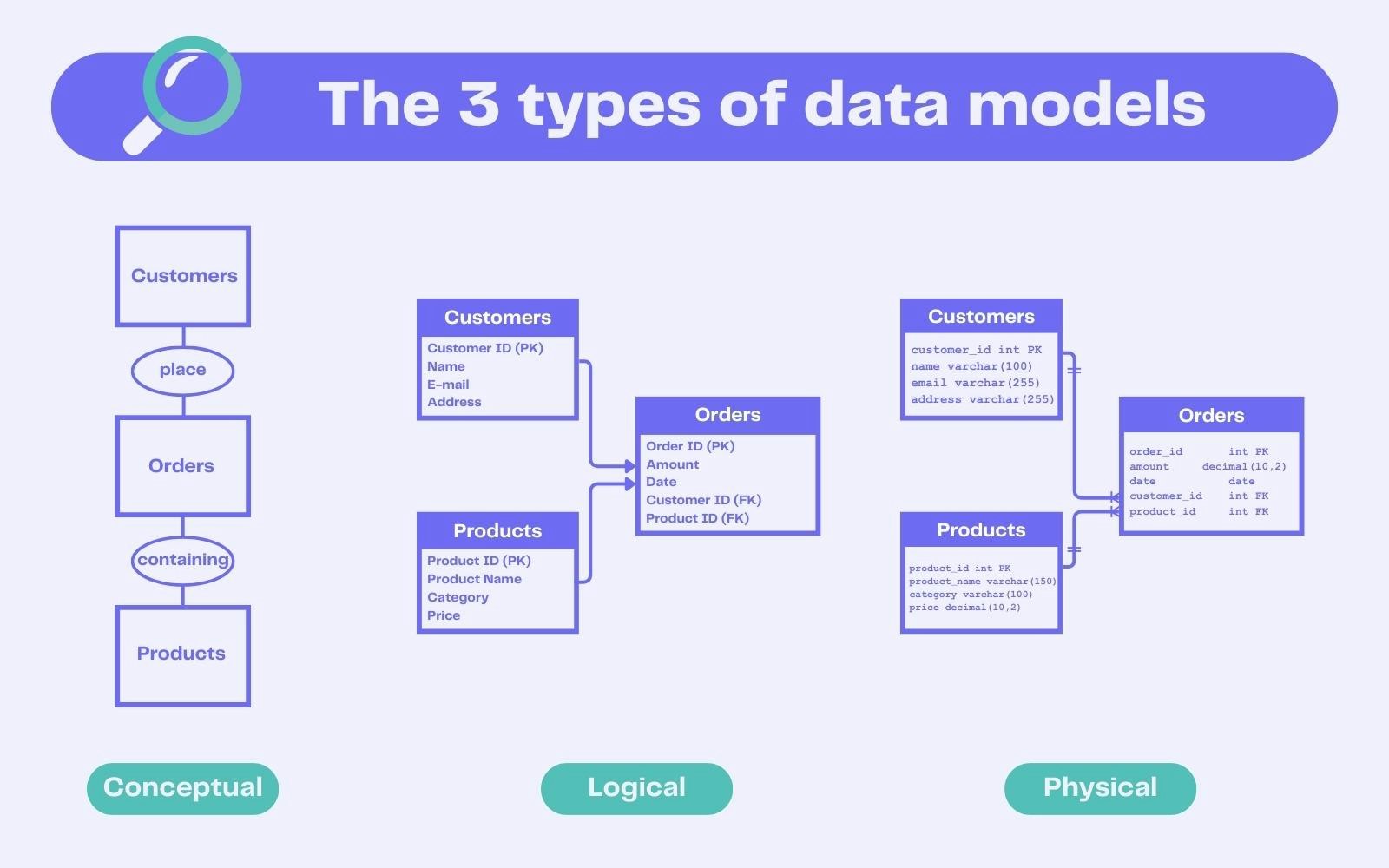
Understanding the data model, from concept to activation
6min • Last updated on Nov 20, 2025

Olivier Renard
Content & SEO Manager
[👉 Summarise this article using ChatGPT, Google AI or Perplexity.]
Nearly 6 out of 10 business leaders today believe that data is a vital lever for growing their company (Jedha). A figure that mirrors the strong growth in the data warehouse and data lake markets.
In most organisations, data is scattered across multiple systems. To become usable and valuable, it needs to be reliable, consistent, and structured according to a well-defined schema.
Key Takeaways:
A data model structures and organises a company’s information to make it usable.
There are several types of models (conceptual, logical, physical), each meeting specific needs.
A well-designed data model facilitates governance, improves data quality, and accelerates decision-making.
In the age of the cloud and the Modern Data Stack, data models remain as essential as ever. DinMo’s model connects customer data to marketing scenarios that generate value.
🔎 What exactly is a data model? What types exist, and what role does it play in data management? What are its benefits and applications, from operational steering to marketing use cases? 💡
What is a data model?
A data model is a structured and visual representation of information.
It defines entities (e.g. customer, order, product), their attributes (name, date, price), and the relationships between them.
Its role is simple but essential: to organise, standardise, and ensure consistency across data. Each object is clearly defined, with a primary key serving as a unique identifier.
Depending on the situation, the data model may precede the database to define its architecture, or it may be created afterwards to document or optimise an existing database.
It makes data easier to use, whether in software, a marketing platform, or BI analysis.

From data modelling to activation
Why is it essential?
Building a data model isn’t just a technical task, it’s the foundation of any data-driven strategy.
It ensures reliable reporting: key metrics like average basket value or conversion rate are only meaningful if built on high-quality data.
It improves communication between marketing, sales, data, and IT teams. Everyone shares the same language and definitions.
The semantic layer unifies how data is understood and used.
It supports governance and helps ensure regulatory compliance (GDPR, CCPA). Clear modelling allows for better traceability and easier management of access rights and consent.
It enhances decision-making. Consistent, well-structured data forms a solid foundation for business intelligence, CDPs, or even AI models.
💡 Imagine a retailer without a clear data model: product data is stored in various formats, and some orders are missing key fields.
The resulting reports show discrepancies, the analyses are skewed, and teams can’t rely on the figures. Strategic decisions are then built on a shaky foundation.

Typical E-commerce Data Model supported by DinMo
The three main types
A data model typically includes three levels, which follow a logical sequence and serve different audiences:
1️⃣ Conceptual data model (CDM)
This provides a high-level view focused on business needs. It’s a simple, schematic representation of data blocks (customers, products, orders) and their relationships — without technical detail.
Main entities are shown as rectangles, connected by arrows. The CDM is used by operations teams, analysts, and project managers to share a common understanding.
2️⃣ Logical model
This translates the conceptual schema into precise rules. Attributes, data types, and cardinalities are defined.
For example, the customer name field is defined as text, and the order date as a date format. A customer may place multiple orders, but each order is linked to a single customer (1–n cardinality).
This model is used by data engineers and architects to prepare for technical implementation.
3️⃣ Physical model
This is the technical implementation. It describes the tables, columns, primary keys, and relationships in a database (e.g. a CUSTOMER table with fields like id, name, email).
This model is used by developers and DBAs to deploy the operational structure.

Conceptual vs logical vs physical data model
Application examples
A data model responds to specific business needs. A few real-world examples by sector:
E-commerce: the model links customer data, orders, and abandoned baskets. This allows for behavioural analysis, historical cross-referencing, and better campaign targeting.
SaaS: it tracks users across their lifecycle. Data from free trials and product usage can identify churn risks and trigger retention or upsell actions.
Other sectors: in finance, it structures compliance and transaction data; in healthcare, it connects patient records, treatments, and monitoring.
💡 The term Common Data Model (CDM) refers to a shared language that standardises key objects (customers, accounts, products, transactions). It provides a common foundation that makes system integration simpler and more reliable.
Data Modelling and the Modern Data Stack
Data models first appeared in the 1960s–70s to structure on-premise relational databases managed in closed, local environments.
Today, most organisations use modern infrastructures, with cloud-based data warehouses (BigQuery, Snowflake, Redshift) at the core. These serve as a single source of truth, where data is centralised before fuelling business tools.
The Modern Data Stack, built around best-of-breed components, has reinforced this approach. Modular and collaborative models have emerged, with tools like dbt or Looker/LookML. These simplify the creation, documentation, and maintenance of data models.
Value now lies in the ability to connect and activate data. A well-designed data model enables a composable CDP to tap directly into the warehouse, unifying profiles and powering large-scale activation scenarios.
DinMo: a data model designed for activation
Traditional CDPs often impose a rigid data model. Businesses must fit into predefined templates — a customer model, a transaction model — with little flexibility for specific use cases.
Unfortunately, these standard schemas don’t suit every reality. A marketplace may need to manage both sellers and end-buyers. Some companies operate in hybrid B2B/B2C models.
With DinMo, you retain full control and we support you in designing the right structure. Our data model, the Knowledge Store, connects directly to your data warehouse. It avoids rigid templates and allows for a customised, adaptive model that fits your business.
The benefits of this approach:
Dynamic segmentation: detect inactive customers faster, identify high-potential prospects, or target strategic accounts.
Omnichannel activation: orchestrate campaigns seamlessly across email, SMS, push, ads.
Team alignment: marketing and data teams work from the same reliable, up-to-date foundation.
💡 An e-commerce business can automatically segment at-risk customers, personalise follow-up emails, and sync that data with advertising campaigns — with no duplication and maximum agility.
Steps to Build an Effective Data Model
Building a data model is a progressive process with key steps:
Identify business needs: before modelling, define the use cases and questions your data should answer. Which customers have been inactive for 90+ days? What’s the average basket value by segment?
List key entities: customers, products, orders, campaigns, etc. These form the foundation of your model. They will make up the tables in the database, with attributes serving as the columns.
Define relationships: a customer can place several orders; each order contains multiple products. These links structure the model and prevent inconsistencies.
Choose the right level of detail: conceptual for business vision, logical to define rules, physical for technical deployment.
Implement governance: control quality, secure access, ensure compliance (GDPR, CCPA).
Plan for scalability: static systems become obsolete. Your model should accommodate new sources and metrics over time.
Common challenges and pitfalls to avoid
Too much complexity: overly heavy models are hard to maintain.
Neglected quality: inaccurate or outdated data causes cascading errors.
Lack of business input: skipping the conceptual step or excluding operational teams reduces adoption.
Siloed work: marketing, IT, and data must share a unified vision to avoid disconnection.
📌 Best practices for a successful data model:
Collaborate: involve marketing, sales, IT, and data teams from day one.
Document: keep definitions and rules accessible to all.
Plan for scalability: your model should evolve with new needs and data sources.
Use the right tools: leverage solutions that simplify implementation.
Conclusion
The data model is the foundation of any data strategy. When aligned with your business needs, it guarantees reliable, consistent, and actionable information. It unlocks valuable insights to power your marketing, sales, and operations.
DinMo makes it easy to design and deploy data models tailored to your needs. Our composable approach lets you activate your customer data faster and with greater impact.
👉 Get in touch to see how DinMo can help you turn your data models into a performance driver.
FAQ
What is data modelling?
What is data modelling?
Data modelling is the practice of representing an organisation’s data in a clear, structured way. It defines entities (customers, products, orders), their attributes, and their relationships.
The aim is to make information consistent, usable, and understandable to all. It’s a critical step to ensure reliable analysis, simplify governance, and accelerate decision-making.
What tools can be used to create a data model?
What tools can be used to create a data model?
Several tools exist for designing data models.
Some are enterprise-grade, like erwin Data Modeler (Quest) or PowerDesigner (SAP). Others are more accessible, such as dbdiagram, Lucidchart, or even Excel, which remains a practical option for simple structuring.
The choice depends on the level of complexity and your technical or business needs.





















